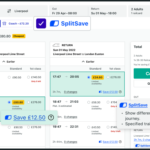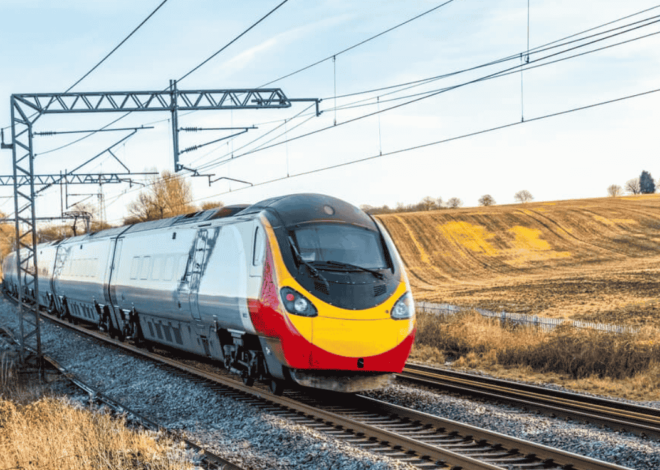
Split Train Tickets in the UK: How to Slash Your Travel Costs
Traveling by train across the UK can be both a convenient and scenic experience. However, ticket prices can sometimes be daunting, particularly for long journeys. One effective strategy to mitigate these costs is the use of split train tickets. This method, while somewhat unconventional, can yield substantial savings on rail fares. This guide explores how split ticketing works and how you can leverage it to reduce your travel expenses.
Understanding Split Ticketing:
What is Split Ticketing?
Split ticketing involves breaking a long train journey into two or more shorter segments, each with its own ticket. By purchasing multiple tickets for these shorter legs, travelers can often benefit from lower overall costs compared to buying a single continuous ticket for the entire journey.

For instance, if you are traveling from London to Edinburgh, instead of buying one ticket for the full journey, you could purchase separate tickets for London to York and York to Edinburgh. This can sometimes lead to significant cost reductions.
Why Does Split Ticketing Work?
The concept behind split train tickets is rooted in the pricing structure of the UK rail network. Train fares are set according to various factors, including the distance traveled, the time of booking, and the specific routes taken. By splitting your journey, you might exploit pricing anomalies and find that shorter segments are cheaper when combined than a single long journey.
How to Split Your Fare:
Tools and Resources:
Several tools and platforms are available to assist travelers in splitting their tickets effectively. Websites such as Trainline and Split Ticketing UK provide functionalities that automatically calculate the potential savings by comparing different ticket combinations. These platforms streamline the process, allowing you to find the most cost-effective tickets without manually checking each possible combination.
Manual Split Ticketing:
For those who prefer a more hands-on approach, manually checking split train tickets involves comparing the cost of buying individual tickets for various segments of your journey. Consider the following steps:
Identify Major Interchange Stations: Determine key stations along your route where you could feasibly break your journey. These should ideally be major hubs with frequent services.
Check Individual Fares: Look up ticket prices for travel between these intermediate stations. Compare these costs against the fare for a single, uninterrupted journey.
Combine Tickets: Purchase the individual tickets for each segment. Ensure that the connections between these segments are feasible within the allowed transfer times.
Examples of Split Ticketing in Action:
Example 1: London to Glasgow
A journey from London to Glasgow can be split into two segments: London to Manchester and Manchester to Glasgow. By purchasing these two tickets separately, travelers may find that this combination is less expensive than a direct London to Glasgow ticket.
Example 2: Bristol to Edinburgh
Travelers heading from Bristol to Edinburgh might split their journey into Bristol to Birmingham and Birmingham to Edinburgh. This segmentation can reveal cost savings, particularly if booked well in advance.
Benefits of Split Train Tickets:
Cost Savings:
The primary advantage of split train tickets is the potential for significant cost savings. By taking advantage of fare pricing strategies and anomalies, travelers can reduce their overall ticket expenses.
Flexibility:
Split ticketing can also offer greater flexibility in terms of travel times and routes. If you’re open to making a stopover or adjusting your departure time slightly, you might discover even more economical options.
Availability:
In many cases, Cheap Train Tickets are more readily available for shorter segments of a journey. This increased availability can be advantageous, especially during peak travel times when long-distance tickets might be sold out.
Considerations and Limitations:
Legal and Practical Concerns:
While split ticketing is a legitimate practice, it is essential to ensure that your tickets cover the entire journey and that you follow the terms and conditions. Some train operators may have specific rules regarding ticket validity and connections, so it’s crucial to check these details when purchasing.
Potential Inconveniences:
Splitting your fare may require changing trains or making brief stops during your journey. Ensure that you have sufficient time to make these connections and that you’re comfortable with the potential additional leg of your trip.
Booking and Reservation:
When using split train tickets, ensure that all parts of your journey are covered by reservations where necessary. If your journey involves reserved seats, you will need to book these separately for each segment.
Tips for Maximizing Savings with Split Tickets:
Book in Advance:
Split train tickets tend to offer the best value when booked well in advance. Prices generally increase as the travel date approaches, so early booking can secure the most affordable fares.
Use Price Comparison Tools:
Utilize online tools and apps designed to find the best split ticketing options. These tools can save time and ensure that you are getting the best possible price for your journey.
Be Flexible with Travel Times:
Flexibility with travel dates and times can lead to more significant savings. Off-peak hours typically offer cheaper fares, and adjusting your travel plans accordingly can enhance your savings.
Conclusion:
Split Train Tickets offer a valuable opportunity for travelers to reduce their rail expenses while exploring the UK. By understanding the principles of split ticketing and leveraging tools to find the most economical combinations, travelers can enjoy significant cost savings. Whether you are planning a short journey or a long-distance adventure, employing the strategy of splitting your fare can make train travel more affordable and accessible.








